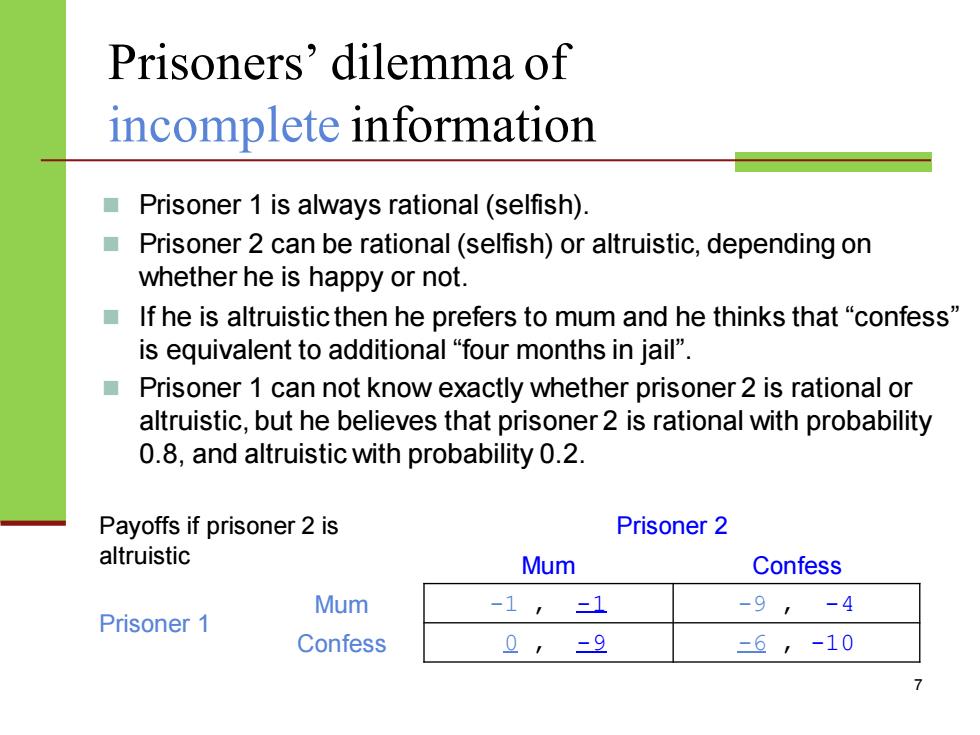
Prisoners'dilemma of incomplete information ■ Prisoner 1 is always rational(selfish). ■ Prisoner 2 can be rational(selfish)or altruistic,depending on whether he is happy or not. ■If he is altruistic then he prefers to mum and he thinks that“confess” is equivalent to additional "four months in jail". Prisoner 1 can not know exactly whether prisoner 2 is rational or altruistic,but he believes that prisoner 2 is rational with probability 0.8,and altruistic with probability 0.2. Payoffs if prisoner 2 is Prisoner 2 altruistic Mum Confess Mum -1, -1 -91 -4 Prisoner 1 Confess -9 -6,-10 7
Prisoners’ dilemma of incomplete information Payoffs if prisoner 2 is altruistic Prisoner 2 Mum Confess Prisoner 1 Mum -1 , -1 -9 , -4 Confess 0 , -9 -6 , -10 7 ◼ Prisoner 1 is always rational (selfish). ◼ Prisoner 2 can be rational (selfish) or altruistic, depending on whether he is happy or not. ◼ If he is altruistic then he prefers to mum and he thinks that “confess” is equivalent to additional “four months in jail”. ◼ Prisoner 1 can not know exactly whether prisoner 2 is rational or altruistic, but he believes that prisoner 2 is rational with probability 0.8, and altruistic with probability 0.2
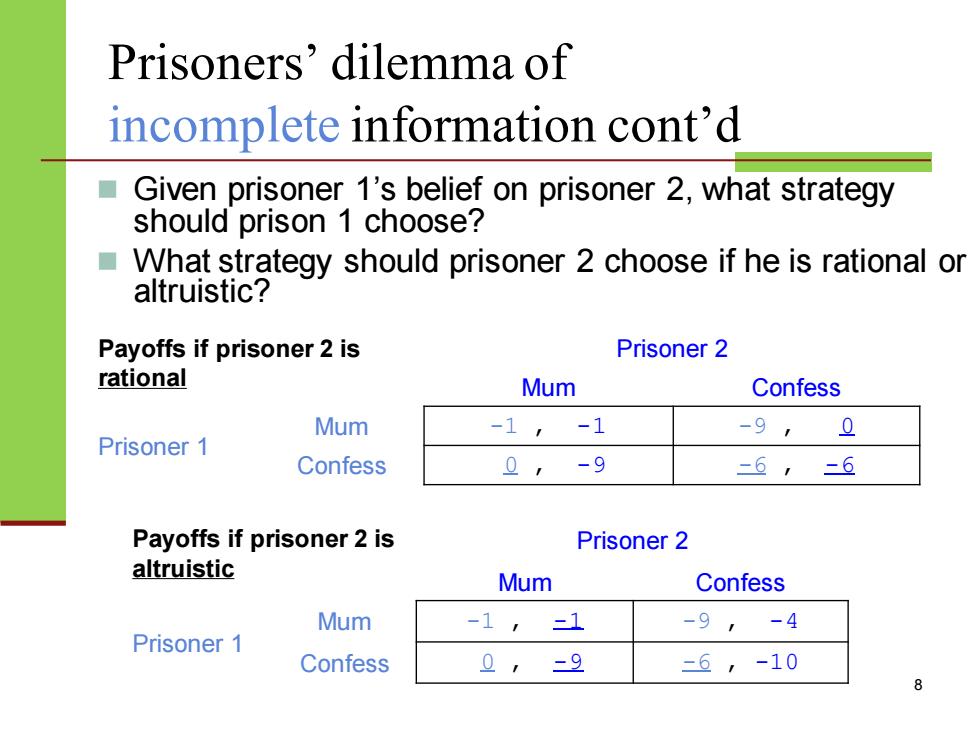
Prisoners'dilemma of incomplete information cont'd ■ Given prisoner 1's belief on prisoner 2,what strategy should prison 1 choose? ■ What strategy should prisoner 2 choose if he is rational or altruistic? Payoffs if prisoner 2 is Prisoner 2 rational Mum Confess Mum -1 -1 -9, 0 Prisoner 1 Confess 0 -9 -6,-6 Payoffs if prisoner 2 is Prisoner 2 altruistic Mum Confess Mum -1, -1 -9 -4 Prisoner 1 Confess 0 -9 =6,-10
Prisoners’ dilemma of incomplete information cont’d Payoffs if prisoner 2 is rational Prisoner 2 Mum Confess Prisoner 1 Mum -1 , -1 -9 , 0 Confess 0 , -9 -6 , -6 8 ◼ Given prisoner 1’s belief on prisoner 2, what strategy should prison 1 choose? ◼ What strategy should prisoner 2 choose if he is rational or altruistic? Payoffs if prisoner 2 is altruistic Prisoner 2 Mum Confess Prisoner 1 Mum -1 , -1 -9 , -4 Confess 0 , -9 -6 , -10
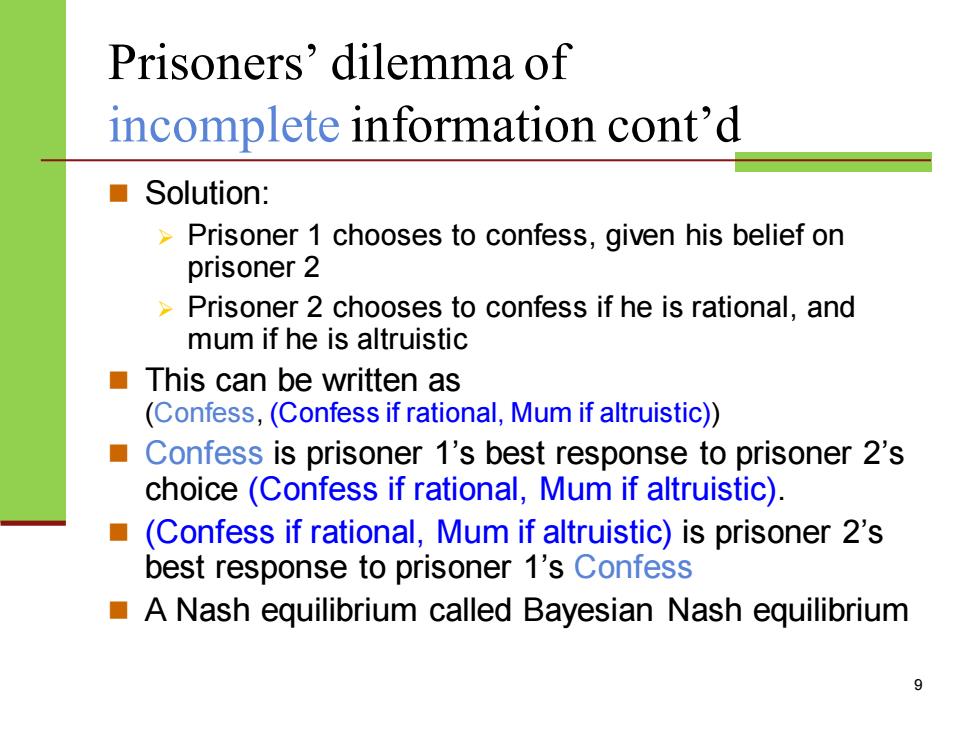
Prisoners'dilemma of incomplete information cont'd ■Solution: -Prisoner 1 chooses to confess,given his belief on prisoner 2 Prisoner 2 chooses to confess if he is rational,and mum if he is altruistic ■This can be written as (Confess,(Confess if rational,Mum if altruistic)) Confess is prisoner 1's best response to prisoner 2's choice(Confess if rational,Mum if altruistic). (Confess if rational,Mum if altruistic)is prisoner 2's best response to prisoner 1's Confess A Nash equilibrium called Bayesian Nash equilibrium
Prisoners’ dilemma of incomplete information cont’d ◼ Solution: ➢ Prisoner 1 chooses to confess, given his belief on prisoner 2 ➢ Prisoner 2 chooses to confess if he is rational, and mum if he is altruistic ◼ This can be written as (Confess, (Confess if rational, Mum if altruistic)) ◼ Confess is prisoner 1’s best response to prisoner 2’s choice (Confess if rational, Mum if altruistic). ◼ (Confess if rational, Mum if altruistic) is prisoner 2’s best response to prisoner 1’s Confess ◼ A Nash equilibrium called Bayesian Nash equilibrium 9
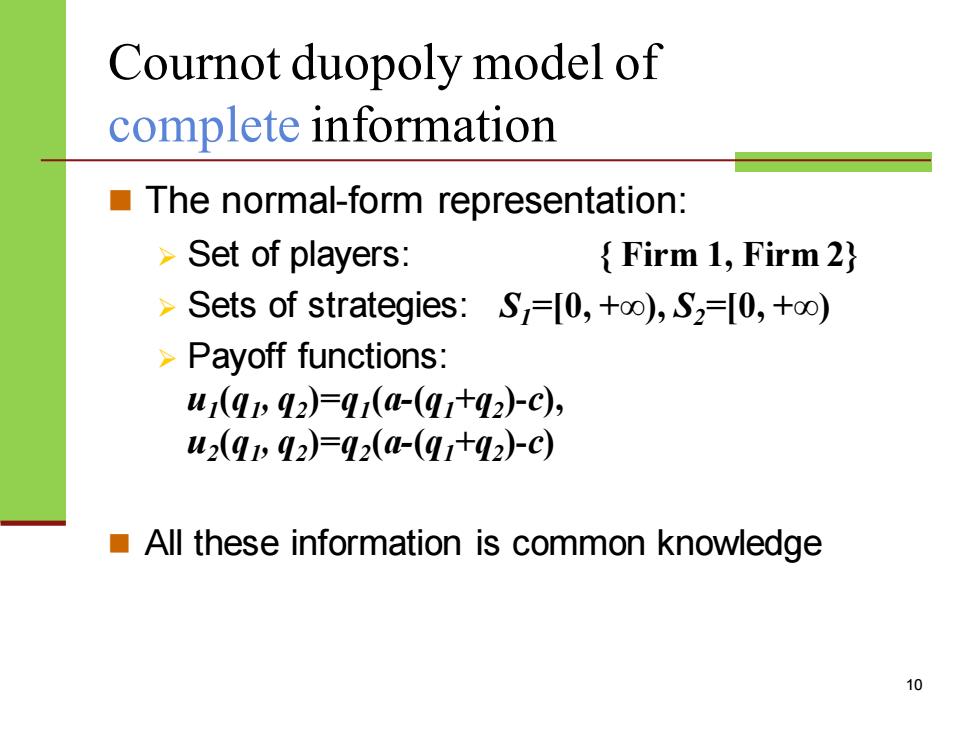
Cournot duopoly model of complete information The normal-form representation: -Set of players: Firm 1,Firm 2) Sets of strategies:S=[0,+oo),S2=10,+o0) >Payoff functions: u(qw92)=q(a-(91+92-C), u2(9wq2)=q2(-(q1+42c) All these information is common knowledge 10
Cournot duopoly model of complete information ◼ The normal-form representation: ➢ Set of players: { Firm 1, Firm 2} ➢ Sets of strategies: S1 =[0, +∞), S2 =[0, +∞) ➢ Payoff functions: u1 (q1 , q2 )=q1 (a-(q1+q2 )-c), u2 (q1 , q2 )=q2 (a-(q1+q2 )-c) ◼ All these information is common knowledge 10
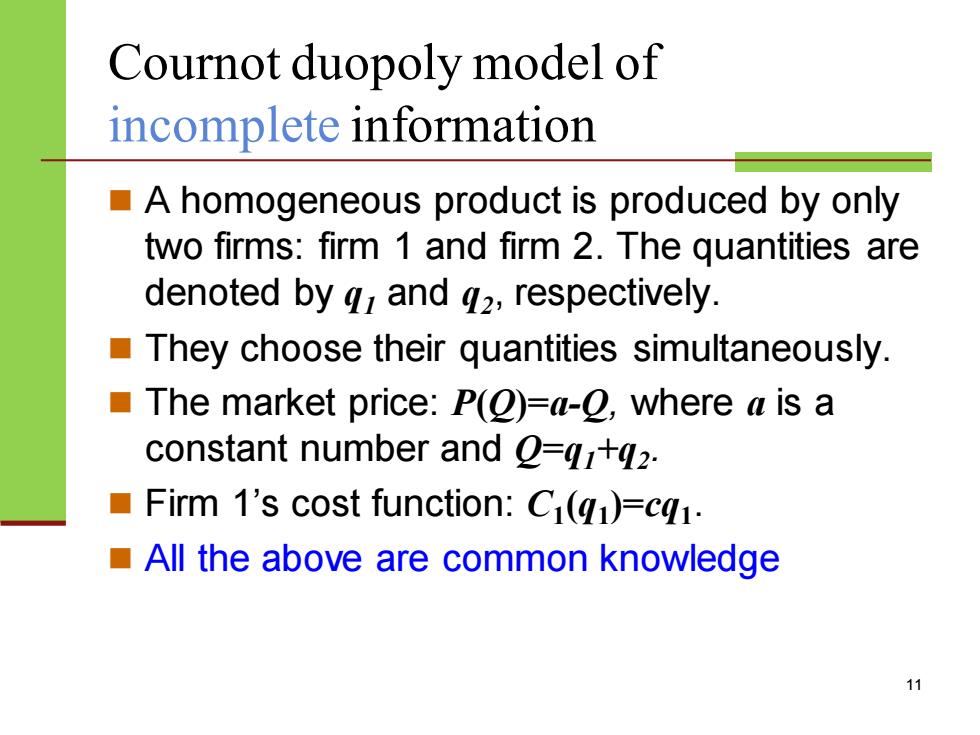
Cournot duopoly model of incomplete information A homogeneous product is produced by only two firms:firm 1 and firm 2.The quantities are denoted by q,and 42,respectively. They choose their quantities simultaneously. The market price:P(O)=a-2,where a is a constant number and Q=q1+q2. Firm 1's cost function:Ci(q1)=cq1. All the above are common knowledge 11
Cournot duopoly model of incomplete information ◼ A homogeneous product is produced by only two firms: firm 1 and firm 2. The quantities are denoted by q1 and q2 , respectively. ◼ They choose their quantities simultaneously. ◼ The market price: P(Q)=a-Q, where a is a constant number and Q=q1+q2 . ◼ Firm 1’s cost function: C1 (q1 )=cq1 . ◼ All the above are common knowledge 11